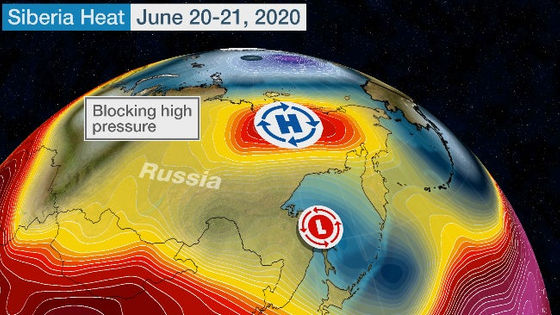Siberian temperature surpasses 38°C, renewing maximum temperature in the Arctic

The temperature in
It Just Hit 100 Degrees Fahrenheit in Siberia, the Hottest Temperature on Record So Far North in the Arctic | The Weather Channel
https://weather.com/news/climate/news/2020-06-21-siberia-russia-100-degrees-heat-record-arctic
Hottest Arctic temperature record likely set in Siberian town-The Washington Post
https://www.washingtonpost.com/weather/2020/06/21/arctic-temperature-record-siberia/
Located in the northeastern part of Siberia, Verkhoyansk is a cold region known as the coldest part of the world. The temperature in the severe cold season is below 50°C below freezing, and it has the lowest temperature record in the northern hemisphere, which is '67.8°C below freezing' certified by the US Meteorological Agency.
On June 20, 2020, a temperature of 100.4°F (38°C) was observed in Verkhoyansk, which is above the highest ever recorded in the Arctic Circle. The average maximum temperature in Verkhoyansk in late June was around 20°C, marking a record heat wave in 2020.
This record heat wave was caused by a meteorological phenomenon called ' blocking '. Blocking is a phenomenon in which a low pressure or high pressure stagnates for a long time without moving due to a large-scale wind such as a westerly wind. Since the same weather will continue if the atmospheric pressure becomes stagnant due to blocking, it will develop into abnormal weather such as long rain, heavy rain, drought, heat wave, cold wave etc. if it is prolonged.
High pressure blocking has continued over Verkhoyansk from June 12th, while the hot air from the south was taken in while the cold was blocked from the north. As a result, temperatures in Verkhoyansk continued to rise from June 12th to June 20th.

The new Verhoyansk high temperature record will be scrutinized and certified as an official record. The World Meteorological Organization commented, 'We are taking preliminary observations as a new record and are considering details.'
Record high temperatures continue in Siberia. The average temperature in May 2020 exceeded the past record by nearly 10 degrees Celsius, and was the “hottest May in observation history” worldwide.
It turned out that May 2020 was ``the hottest May in the history of observation'', in Siberia it exceeds the past average by nearly 10 degrees-GIGAZINE

Since April 2020, wildfires have continued in northern Russia due to the warm and dry weather. The image below shows the state of aerosols in the atmosphere caused by a forest fire. Wildfires have been shown to cause a large amount of aerosols in the Chukchi Autonomous Okrug and the Sakha Republic in northeastern Russia.
Widespread #Siberia #wildfires are producing a lot of heavy smoke predicted to recirculate over Chukotka & Sakha Republic in coming days by latest @CopernicusECMWF Atmosphere Monitoring Service @ECMWF aerosol forecast https://t.co/248qWnjG83 @CopernicusEU #ArcticWildfires pic.twitter .com/B1olE4Ms1D
— Mark Parrington (@m_parrington) June 20, 2020
Related Posts:
in Science, Posted by darkhorse_log







